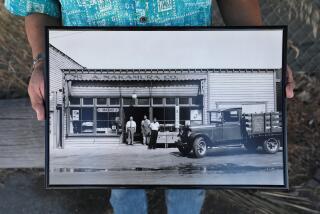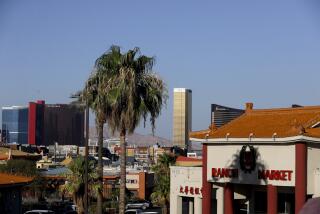Council Asked to Establish Asian Historic District : Architect Urges Resurrection of Chinatown
- Share via
San Diego needs a Chinatown, architect Wayne Donaldson says, and preserving 19 downtown buildings as part of a Chinese/Asian Thematic Historic District would be a good first step in re-establishing one.
“The history of San Diego is very Chinese, but you wouldn’t know it to look at it,” Donaldson said.
Friday, the Centre City Development Corp. will decide whether to recommend that the 19 buildings--”the last remnants of the Chinese community,” Donaldson calls them--be designated as the core of a Chinese/Asian Thematic Historic District. The San Diego City Council would have to approve the measure before the district is added to the local historical registry and nominated for the national registry.
The district is in the lower 5th Avenue area south of Martin Luther King Way. The CCDC toured several of the buildings Wednesday, but it will not make its recommendation until Friday.
Lacking a Chinatown
“We’re the only major Pacific Rim city that does not have a bona fide Chinatown, a thriving Chinatown. Even Bakersfield has a more viable Chinatown,” Donaldson said.
Donaldson, who has done research for the CCDC on the area, said much of San Diego’s Chinatown was destroyed shortly before the Panama Exposition of 1915, when authorities wanted to “clean up” the area, which at the time was the site of bars and brothels. The buildings that would form the core of the historic district are the last of scores of buildings that Chinese immigrants owned, lived in and worked in during the late 19th and early 20th centuries.
One major obstacle to re-establishing a Chinatown is that there are very few Chinese-Americans left downtown. Beginning in the 1930s and accelerating in the 1960s, many of them left the San Diego area or moved to the suburbs, and saving some buildings downtown will not bring them back, CCDC officials said.
Pam Hamilton, CCDC assistant vice president, said it will be difficult for a Chinatown to re-emerge simply because it has been dormant for so long.
“The issues on a Chinatown are kind of touchy, because the Chinatowns on the West Coast were natural phenomenons,” she said, “and I think it would be rather arbitrary to try to put one together.”
Hamilton said that if a Chinatown is re-established, it should not be forced or artificial.
The Chinese/Asian Thematic Historic District is so named because many Japanese, Filipinos and Hawaiians settled there with the Chinese, who arrived in the late 19th Century. After racially motivated exclusionary laws were passed, however, “little by little, the community dwindled away,” said Dorothy Hom, who has been active in the effort to preserve what is left of Chinatown.
Preserve Heritage
“We want to save as many buildings as we can,” Hom said. “At one of the first CCDC meetings we went to--the old-timers and some of the young ones, too--(the CCDC members) said, ‘Why do you care about these buildings?’ And one fellow said, ‘We know this is where the Chinese were, and we want to preserve as much of the heritage as we can.’ ”
Under the proposal, which is scheduled to go to the City Council later this month, the historic but run-down Chinese Mission Building would be exempted from the historic district. The building housed the Chinese Community Church until 1959, when the church sold the building.
The current owner, Charles P. Tyson, wrote to CCDC: “While I respect and understand the sentimental attachment members of the Chinese Community Church have for their former home, the property today bears no resemblance to what it was 28 years ago when they vacated it. Nothing is left that is reminiscent of their use.”
Because of that, and because the building is unsafe and inhabited by transients, Tyson requested that the building be allowed to be torn down.
Hamilton said she agreed that the building probably is beyond repair, and the CCDC staff has recommended that it be torn down. ‘ ‘We’re trying to blend special interests: the rights of property owners and the psychological and emotional attitudes of the Chinese community to those buildings,” she said.
The staff also recommended that CCDC allow developers to tear down the Woo Chee Chong Building on 3rd Avenue and the Regal and Anita hotels on 4th Avenue because refurbishing them would be too costly.
More to Read
Sign up for Essential California
The most important California stories and recommendations in your inbox every morning.
You may occasionally receive promotional content from the Los Angeles Times.










